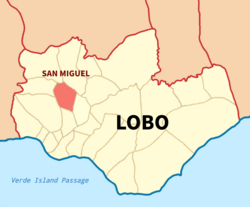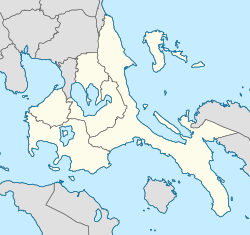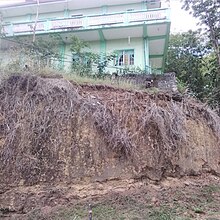| This article needs additional citations for verification. Please help improve this article by adding citations to reliable sources. Unsourced material may be challenged and removed. Find sources: "San Miguel, Lobo" – news · newspapers · books · scholar · JSTOR (March 2023) (Learn how and when to remove this message) |
| San Miguel Barangay San Miguel | |
|---|---|
| Barangay | |
  From left to right: Sitio Centro, San Miguel Barangay Hall From left to right: Sitio Centro, San Miguel Barangay Hall | |
 Seal Seal | |
 Map of San Miguel, Lobo, Batangas Map of San Miguel, Lobo, Batangas | |
 | |
| Coordinates: 13°41′N 121°13′E / 13.683°N 121.217°E / 13.683; 121.217 | |
| Country | Philippines |
| Region | Calabarzon |
| Municipality | Lobo, Batangas |
| District | 2nd District |
| Established | October 28, 1959 |
| Government | |
| • Type | Barangay |
| • Punong Barangay | Roosevelt G. Dueñas |
| Area | |
| • Total | 3.214 km (1.241 sq mi) |
| Population | |
| • Total | 769 |
| Time zone | UTC+8 (PST) |
| Postal Code | 4229 |
San Miguel (officially Barangay San Miguel) is a 5th class barangay and one of the 26 barangays constituting the municipality of Lobo, Batangas, Philippines. It is a rural community situated north of the municipality and is about ten minutes drive from Poblacion. Barangay San Miguel is politically subdivided into five sitios: Centro, Banbanan (Banbanan I, Banbanan II), Dayapan (Dayapan I and Dayapan II).
Etymology
According to a legend, the origins of Barangay San Miguel are connected with Barangay Tayuman. As the story goes, while a group of respected elders were strolling through a bamboo forest one day, they were surprised by a sight—a divine image of Saint Michael manifested before their eyes. Overwhelmed by the sacredness of the encounter, the wise elders bestowed the name San Miguel upon the place. With the passage of time, the once-inseparable part of Barangay Tayuman underwent remarkable growth and development, ultimately gaining its independence as a thriving barangay. This remarkable journey from its humble beginnings to an independent community exemplifies the enduring legacy of San Miguel.
History
In the year 1959, Barangay San Miguel was once part of Tayuman along with now Balatbat, and Poblacion until it was created by the Republic Act No. 3383 (also known as the Act Converting the Sitio of Viga in Tayuman, Lobo, Batangas into the Barrio of San Miguel) in Lobo, Batangas. It is located in the north of the town and is considered a place of livelihood of the citizens. During this time, most of the residents were engaged in farming and growing crops such as rice and coconut. At that time, Barangay San Miguel consisted of three sitios - Centro, Banbanan, and Dayapan. In each sitio, there are servants (now known as "Councilors") assigned to look after the welfare of their residents. The existence of sitios shows the organizedness of the community despite the challenges of life in those times. In the political field, Barangay San Miguel is constantly changing. During the creation of municipalities and barangays under the Republic of the Philippines in 1959, Barangay San Miguel became part of the town of Lobo. In the following years, the population of the area continued to increase and the livelihood of the community continued to expand. Currently, Barangay San Miguel continues to integrate with the activities of the Municipality of Lobo.
Geography
San Miguel is situated at a distance of 4.80 kilometers from the town proper, with the municipal hall located a few kilometers away. It is surrounded by neighboring areas, with Barangay Malapad na Parang to the north, Barangay Calo to the west, Barangay Balatbat to the south, and Barangay Tayuman and Barangay Nagtaluntong to the east.
Sitios
In the barangay of San Miguel, located in the municipality of Lobo, Batangas, you will find a total of 5 distinct sitios. Among them, a single sitio stands out as the urban center (bold), while the other 4 sitios is known to be simple and rural. Each sitio carries its unique nickname like for instance, in Sitio Centro, locals refer to it as "Ilaya".
| Sitios | Councilors |
|---|---|
| Sitio Banbanan I |
|
| Sitio Banbanan II |
|
| Sitio Centro |
|
| Sitio Dayapan I |
|
| Sitio Dayapan II |
|
Demographics
| Year | Pop. | ±% p.a. |
|---|---|---|
| 1990 | 654 | — |
| 1995 | 723 | +1.90% |
| 2000 | 740 | +0.50% |
| 2007 | 978 | +3.92% |
| 2010 | 732 | −10.01% |
| 2015 | 802 | +1.75% |
| 2020 | 769 | −0.82% |
| Source: Philippine Statistics Authority | ||
Infastracture and utilities
BATELEC II brings electricity to Barangay San Miguel while telephone communication and internet connection is given by Globe Telecom. The Lobo Water District is the water supply provider for this barangay.
Until today, projects are made like: Improving Of Barangay Access Road, Slope Protection, and Road Improvement. These projects helps tourists and locals of the community so they can be safe. They also put lights on the center of the road so when it's dark, you can still see where your going. It is also one of the only barangays that has a bridge named San Miguel Bridge.
Gallery




References
- "2020 Census of Population and Housing (2020 CPH) Population Counts Declared Official by the President | Philippine Statistics Authority". psa.gov.ph. Retrieved July 12, 2021.
- "About San Miguel | Lobo Batangas Tourism Website". ilovelobo.ph. Retrieved 5 March 2023.
- "Philippine Standard Geographic Code (PSGC) | Philippine Statistics Authority". psa.gov.ph. Retrieved 6 March 2023.
- "Philippine Standard Geographic Code for Barangay San Miguel (PSGC) | Philippine Statistics Authority". psa.gov.ph. Retrieved 6 March 2023.
- "About San Miguel | Lobo Batangas Tourism Website". ilovelobo.ph. Retrieved 5 March 2023.
- "Republic Act 3383 | LawPH". lawphil.net. Retrieved 6 March 2023.
- Census of Population (2015). Highlights of the Philippine Population 2015 Census of Population. Philippine Statistics Authority. Retrieved 20 June 2016.
- Census of Population and Housing (2010). Population and Annual Growth Rates for The Philippines and Its Regions, Provinces, and Highly Urbanized Cities (PDF). National Statistics Office. Retrieved 29 June 2016.
- Censuses of Population (1903–2007). Table 1. Population Enumerated in Various Censuses by Region: 1903 to 2007. National Statistics Office.
- "Batangas's 2nd District Bridges | Department of Public Works and Highways". DPWH.gov.ph. Retrieved 6 March 2023.